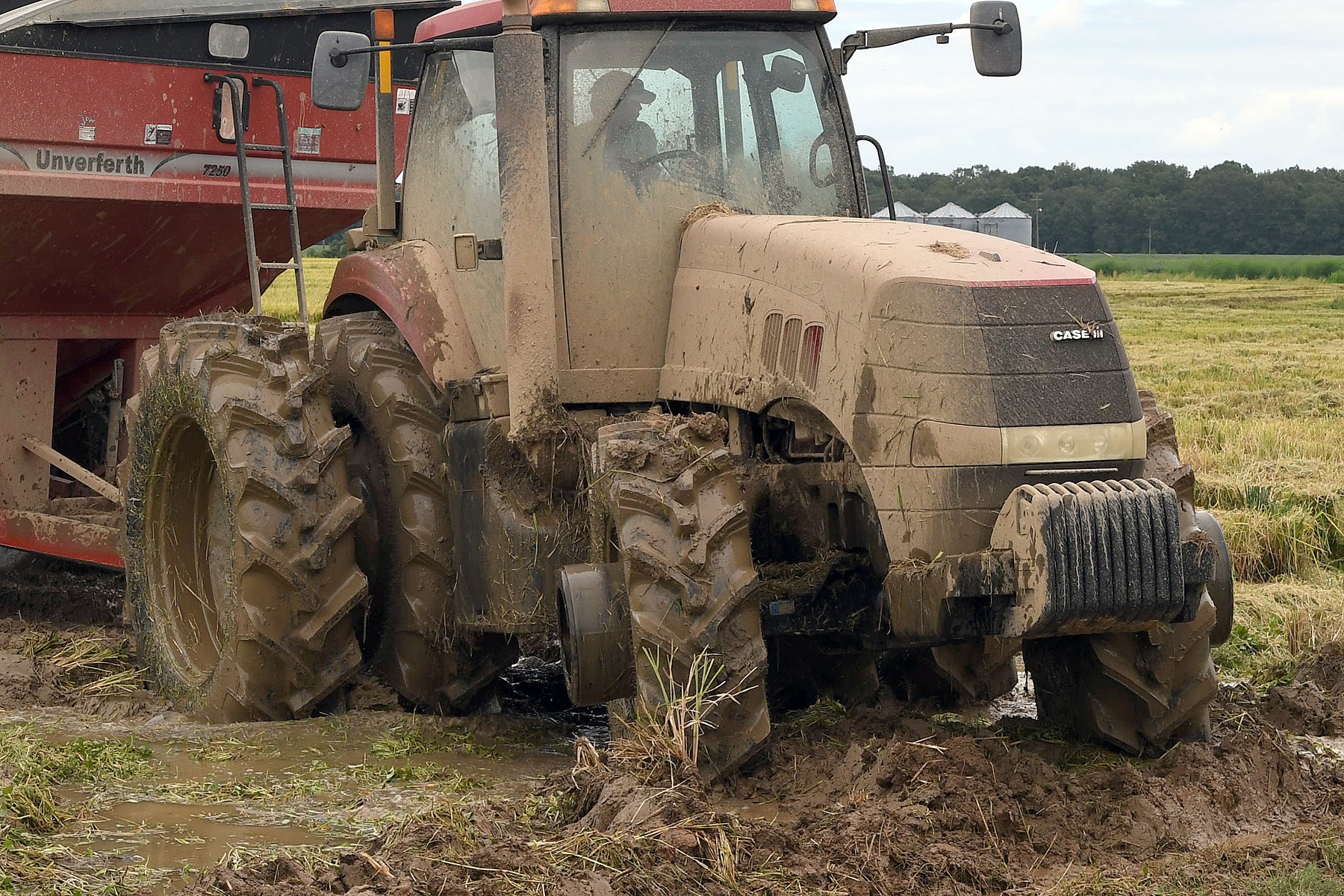Traction and Compaction in Wet Fields
Thoughts of perfect weather and ideal field conditions fill every farmer’s head, but those dreams aren’t always a reality. While we preach patience and believe in biding your time until a field is ready to support equipment, sometimes waiting isn’t an option. In cases when you simply must enter wet and muddy fields, here are some steps you can take to increase flotation, maximize traction, and reduce soil compaction.

Find Your Tire’s Optimal Footprint
Operating your tires at lower inflation pressures increases their footprint, consequently spreading the weight of the machine it’s carrying over a larger area and minimizing soil compaction. Reduced inflation has the added benefit of putting more tread on the ground and improving traction as well.
Optimal vs. Underinflated:
An ag tire’s ideal inflation pressure accounts for the weight of the machine, what it’s carrying, and the speed it is traveling at. Knowing these three factors, you can use the load and speed tables provided by the tire manufacturer. Find a few more tips for putting your farm equipment’s best foot(print) forward in our blog, Finding a Farm Tire’s Optimal Footprint.
- Optimally inflated tires (tires set at the recommended PSI) produce superior traction and minimize compaction, along with other benefits like extending tire life.
- Underinflated tires (tires set under the recommended PSI) don’t correctly place a tire’s tread on the ground, which negatively affects stability, increases fuel consumption, speeds up wear, and can lead to overheating and tire failure.
Field vs. Road:
The fast speeds that farm equipment travels on the road require higher inflation pressure than the low-speed work it performs in the field. For farmers with machines operating in both areas, there are a few options to ensure your machine is operating at its best when in the field. This difference between the two needs is especially pronounced when going from hard roads to soft, muddy fields.
- Central tire inflation system (CTIS): Installing a CTIS allows operators to change the inflation of their tires with the push of a button—ensuring they are always operating at the appropriate inflation pressure. According to our friends at Precision Inflation (a CTIS manufacturer), a CTIS will:
- Boost yields by 6%
- Improve fuel efficiency by 10%
- Provide 20% more traction
- Extend tire life by 20%
- Manually adjust inflation: More time consuming than a CTIS, manually adjusting your equipment’s tires for the terrain they’re working can offer enough benefits—like better traction, optimum slip, more efficient operation in the field and faster travel speeds on the road, to name a few—to make up for the time the process takes.
- Slow down: If a CTIS isn’t in the budget and you can’t bring yourself to adjust inflation between applications, you can travel at slower speeds. For example, running our Alliance Agri Star II in size 710/70R42 at an inflation pressure of 35 psi allows the tire to carry a load of 14,330 lbs at 40 mph, while the same tire running at 23 psi—which may have been perfect for fieldwork—would need to operate at 19 mph to carry the same load safely.
Controlled Traffic Patterns
Controlled traffic, or “tramlining,” has been popular in Europe and Australia for years and is now becoming a popular practice for U.S. farmers working to minimize soil compaction. Since between 70% and 90% of total plow layer compaction occurs on the first trip across the field, tramlining limits the amount of soil that farm machinery travels on by creating permanent traffic lanes and limiting in-field traffic to them.
In addition to reducing soil compaction, establishing permanent traffic lanes can also improve traction as permanently compacted tracks are easier to travel on than soft soil. Other benefits include improved fuel efficiency—thanks to less rolling resistance and wheel slippage—and the ability to use less powerful machinery.
Upgrade Your Tires
Tire technology improves every year and upgrading to high-tech tires is an easy way to improve the traction and reduce the impact of your farm equipment.
- Bias vs. Radial: Radials tires can have a 15–25% larger footprint than a bias tire, which equates to better traction and less impact on your field. Check out our blog, Should I Choose a Radial or a Bias Farm Tire?, to see why so many farmers are choosing radial tires.
- Radial vs. IF/VF: IF/VF tires are like radials on steroids and unlock the full potential of farm equipment—allowing them to carry heavy loads and delicately operate on farmland, and improving their productivity.
- IF tires can carry 20% more load than a conventional radial and operate at 20% less air pressure.
- VF tires can carry 40% more load than a conventional radial and operate at 40% less air pressure.
Is it Time for New Tires?
The disparity in performance between a new tire and a tire toward the end of its tread life is significant. Tires with new tread hook up (or gain traction) better than well-used tires, resulting in improved efficiency and fuel use. It also means less spinning, which equates to less rutting and digging up fields.
Work with Your Dealer
Today’s farmers wear many hats—they’re business people, marketers, agronomists, meteorologists, and mechanics, to name a few—they shouldn’t be required to be tire experts as well. If working in wet fields is in a farmer’s future, they should work with their local dealer to find not only the best tires for their application, but also the steps they can take to ensure they get the best return on their tire investment.
We’re proud of our products as well as our people, who add extra value to all of our customers. Our reps and sales team regularly accompany our dealers into the field (often the literal field) helping users not only find the right tire, but making certain that the tires are set up correctly. Contact your local dealer or rep today to learn more about how we can help improve your operation.


